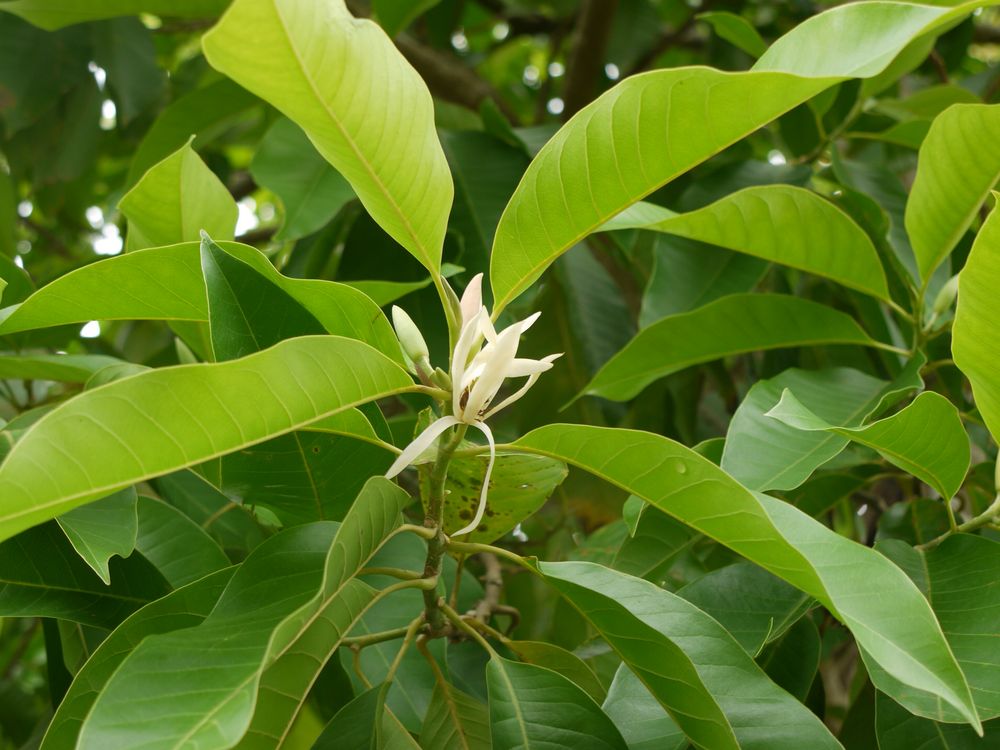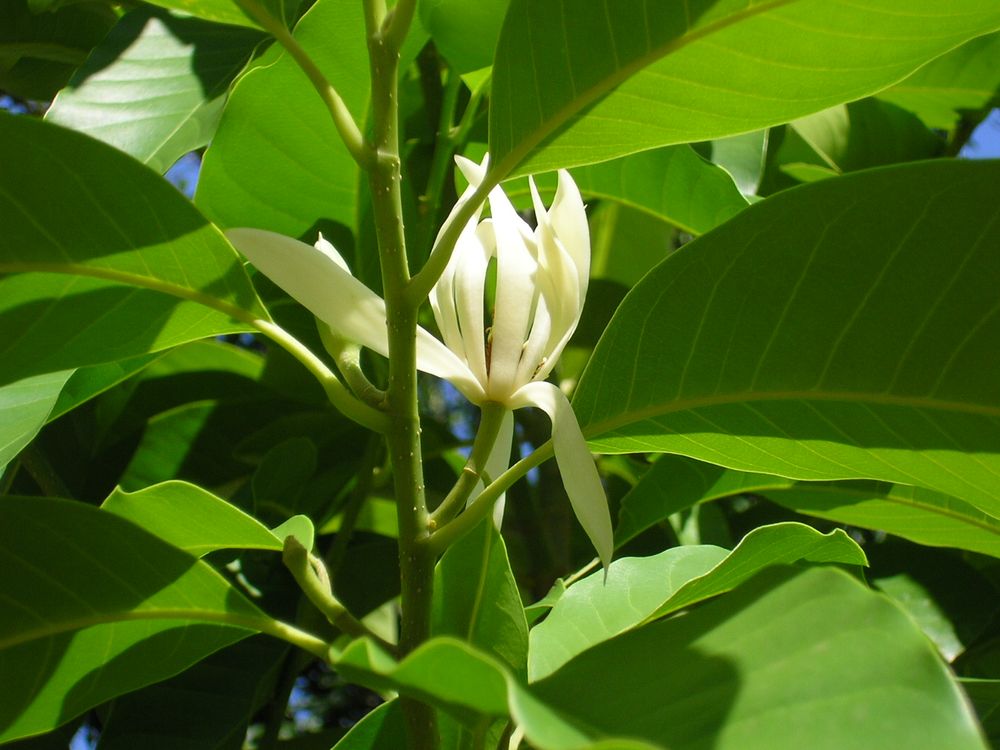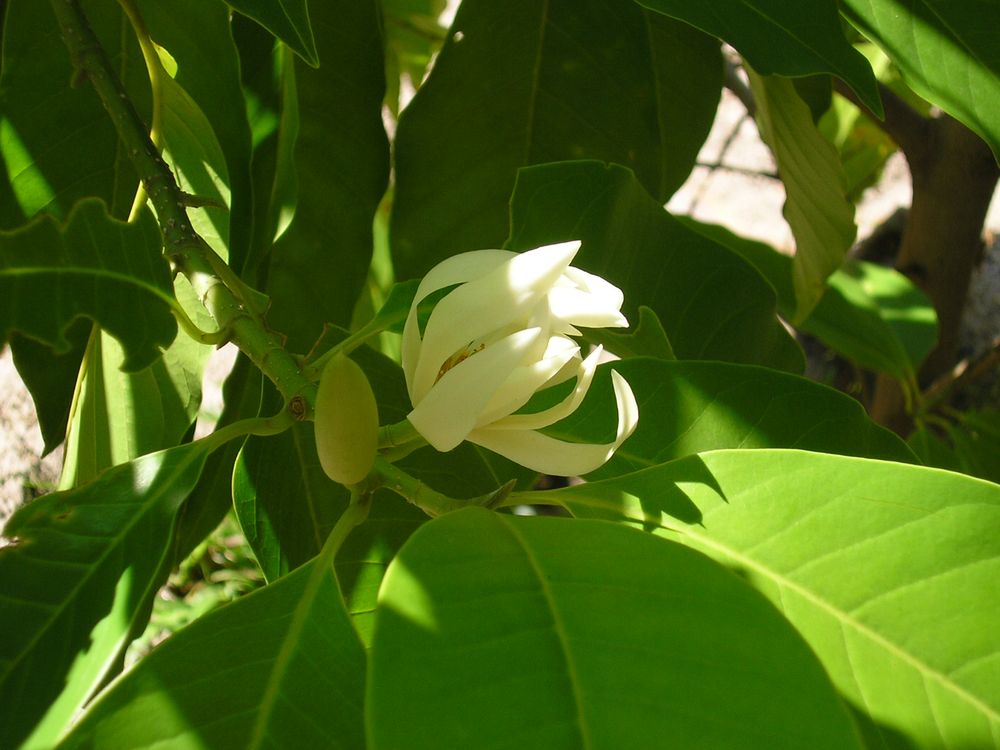Magnolia x alba is a medium-sized tree, even a shrub, with lanceolate leaves and solitary axillary flowers, very fragrant whose petals, with the waxy aspect, are of a creamy white. The dehiscent fruits are very rare. It can be found in many gardens in Laos and around pagodas.
The Lao name this tree champi, from the Sanskrit champa, common name of several plants in India. This Sanskrit name also gave in Lao champa, the frangipani tree, which botanically has nothing to do with the family Magnoliaceae. But the beauty and fragrance of the flowers of the American frangipani tree have brought it closer to the Asian magnolias.
But this perfume, which can be very sweet, becomes almost nauseating when the flowers dry. Once cut, these flowers lose their beauty and turn brown quickly, which makes them difficult to handle in garlands for example.
In Laos, dok champi is used as a medicine: the leaves are used to make an astringent decoction for gargling against angina, the flowers are said to be a heart tonic, the bark and roots are said to treat menstrual disorders and reduce fever.
Magnolia x alba est un arbre de taille moyenne, voire un arbuste, aux feuilles lancéolées et aux fleurs axillaires solitaires, très odorantes dont les pétales, à l’aspect cireux, sont d’un blanc crémeux. Les fruits déhiscents sont très rares. On le trouve dans de nombreux jardins au Laos et autour des pagodes.
Les Lao nomment cet arbre champi, du sanscrit champa, nom commun de plusieurs plantes en Inde. Ce nom sanscrit a donné aussi en lao tiampa, le frangipanier, qui botaniquement n’a rien à voir avec la famille des Magnoliacées mais, la beauté et la fragrance des fleurs du frangipanier américain l’ont rapproché des magnolias asiatiques.
Contre toute attente, ce parfum, qui peut être très suave, devient presque nauséeux quand les fleurs sèchent. Ces fleurs d’ailleurs une fois coupées, perdent de leur superbe et brunissent vite, ce qui les rend difficiles à manipuler dans les guirlandes par exemple.
Au Laos, les dok tiampi sont utilisées comme médicament: avec les feuilles on fait une décoction astringente employée en gargarisme contre les angines, les fleurs seraient un tonique cardiaque, l’écorce et les racines soigneraient les troubles des règles et feraient régresser la fièvre.



Magnolia x alba is a medium-sized tree, even a shrub, with lanceolate leaves and solitary axillary flowers, very fragrant whose petals, with the waxy aspect, are of a creamy white. The dehiscent fruits are very rare. It can be found in many gardens in Laos and around pagodas.
The Lao name this tree champi, from the Sanskrit champa, common name of several plants in India. This Sanskrit name also gave in Lao champa, the frangipani tree, which botanically has nothing to do with the family Magnoliaceae. But the beauty and fragrance of the flowers of the American frangipani tree have brought it closer to the Asian magnolias.
But this perfume, which can be very sweet, becomes almost nauseating when the flowers dry. Once cut, these flowers lose their beauty and turn brown quickly, which makes them difficult to handle in garlands for example.
In Laos, dok champi is used as a medicine: the leaves are used to make an astringent decoction for gargling against angina, the flowers are said to be a heart tonic, the bark and roots are said to treat menstrual disorders and reduce fever.
Magnolia x alba est un arbre de taille moyenne, voire un arbuste, aux feuilles lancéolées et aux fleurs axillaires solitaires, très odorantes dont les pétales, à l’aspect cireux, sont d’un blanc crémeux. Les fruits déhiscents sont très rares. On le trouve dans de nombreux jardins au Laos et autour des pagodes.
Les Lao nomment cet arbre champi, du sanscrit champa, nom commun de plusieurs plantes en Inde. Ce nom sanscrit a donné aussi en lao tiampa, le frangipanier, qui botaniquement n’a rien à voir avec la famille des Magnoliacées mais, la beauté et la fragrance des fleurs du frangipanier américain l’ont rapproché des magnolias asiatiques.
Contre toute attente, ce parfum, qui peut être très suave, devient presque nauséeux quand les fleurs sèchent. Ces fleurs d’ailleurs une fois coupées, perdent de leur superbe et brunissent vite, ce qui les rend difficiles à manipuler dans les guirlandes par exemple.
Au Laos, les dok tiampi sont utilisées comme médicament: avec les feuilles on fait une décoction astringente employée en gargarisme contre les angines, les fleurs seraient un tonique cardiaque, l’écorce et les racines soigneraient les troubles des règles et feraient régresser la fièvre.






Magnolia x alba is a medium-sized tree, even a shrub, with lanceolate leaves and solitary axillary flowers, very fragrant whose petals, with the waxy aspect, are of a creamy white. The dehiscent fruits are very rare. It can be found in many gardens in Laos and around pagodas.
The Lao name this tree champi, from the Sanskrit champa, common name of several plants in India. This Sanskrit name also gave in Lao champa, the frangipani tree, which botanically has nothing to do with the family Magnoliaceae. But the beauty and fragrance of the flowers of the American frangipani tree have brought it closer to the Asian magnolias.
But this perfume, which can be very sweet, becomes almost nauseating when the flowers dry. Once cut, these flowers lose their beauty and turn brown quickly, which makes them difficult to handle in garlands for example.
In Laos, dok champi is used as a medicine: the leaves are used to make an astringent decoction for gargling against angina, the flowers are said to be a heart tonic, the bark and roots are said to treat menstrual disorders and reduce fever.
Magnolia x alba est un arbre de taille moyenne, voire un arbuste, aux feuilles lancéolées et aux fleurs axillaires solitaires, très odorantes dont les pétales, à l’aspect cireux, sont d’un blanc crémeux. Les fruits déhiscents sont très rares. On le trouve dans de nombreux jardins au Laos et autour des pagodes.
Les Lao nomment cet arbre champi, du sanscrit champa, nom commun de plusieurs plantes en Inde. Ce nom sanscrit a donné aussi en lao tiampa, le frangipanier, qui botaniquement n’a rien à voir avec la famille des Magnoliacées mais, la beauté et la fragrance des fleurs du frangipanier américain l’ont rapproché des magnolias asiatiques.
Contre toute attente, ce parfum, qui peut être très suave, devient presque nauséeux quand les fleurs sèchent. Ces fleurs d’ailleurs une fois coupées, perdent de leur superbe et brunissent vite, ce qui les rend difficiles à manipuler dans les guirlandes par exemple.
Au Laos, les dok tiampi sont utilisées comme médicament: avec les feuilles on fait une décoction astringente employée en gargarisme contre les angines, les fleurs seraient un tonique cardiaque, l’écorce et les racines soigneraient les troubles des règles et feraient régresser la fièvre.


